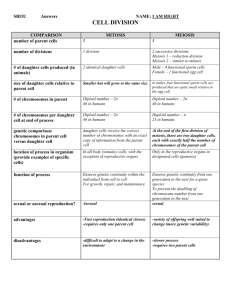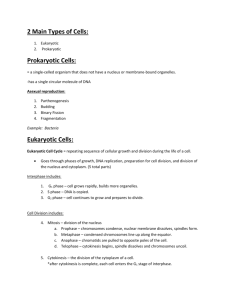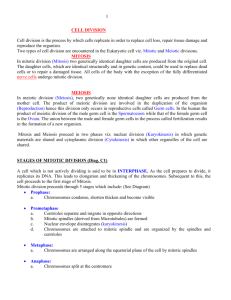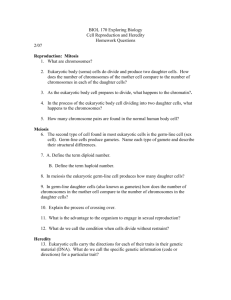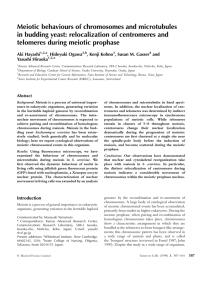Chapter 8 instructor
advertisement
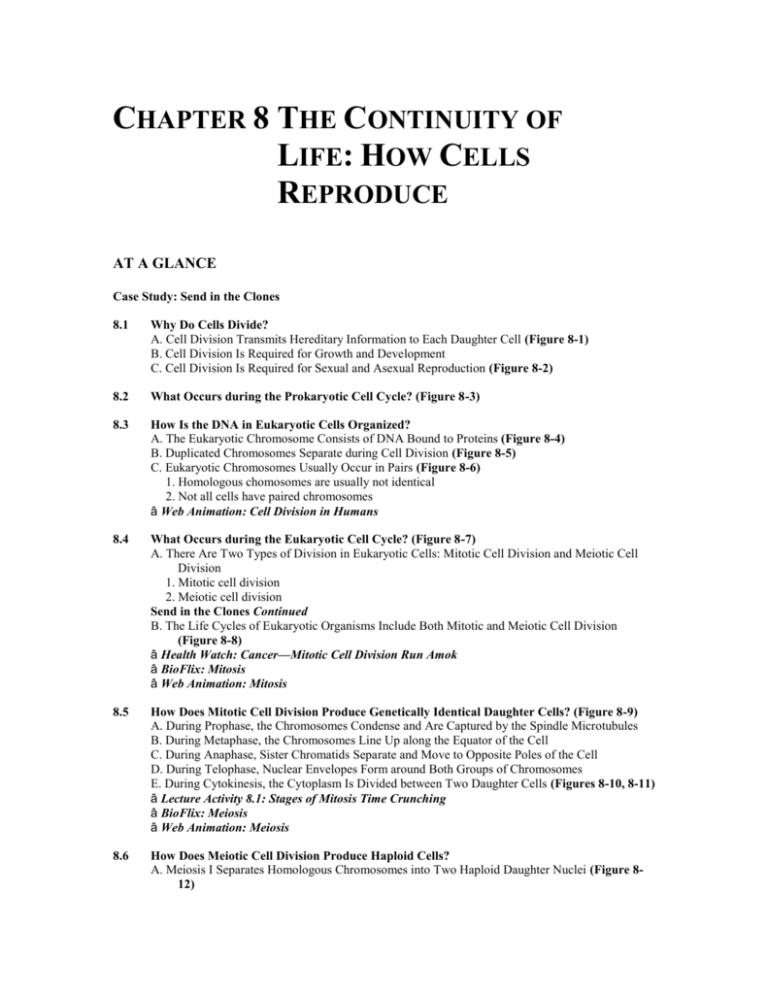
CHAPTER 8 THE CONTINUITY OF LIFE: HOW CELLS REPRODUCE AT A GLANCE Case Study: Send in the Clones 8.1 Why Do Cells Divide? A. Cell Division Transmits Hereditary Information to Each Daughter Cell (Figure 8-1) B. Cell Division Is Required for Growth and Development C. Cell Division Is Required for Sexual and Asexual Reproduction (Figure 8-2) 8.2 What Occurs during the Prokaryotic Cell Cycle? (Figure 8-3) 8.3 How Is the DNA in Eukaryotic Cells Organized? A. The Eukaryotic Chromosome Consists of DNA Bound to Proteins (Figure 8-4) B. Duplicated Chromosomes Separate during Cell Division (Figure 8-5) C. Eukaryotic Chromosomes Usually Occur in Pairs (Figure 8-6) 1. Homologous chomosomes are usually not identical 2. Not all cells have paired chromosomes â Web Animation: Cell Division in Humans 8.4 What Occurs during the Eukaryotic Cell Cycle? (Figure 8-7) A. There Are Two Types of Division in Eukaryotic Cells: Mitotic Cell Division and Meiotic Cell Division 1. Mitotic cell division 2. Meiotic cell division Send in the Clones Continued B. The Life Cycles of Eukaryotic Organisms Include Both Mitotic and Meiotic Cell Division (Figure 8-8) â Health Watch: Cancer—Mitotic Cell Division Run Amok â BioFlix: Mitosis â Web Animation: Mitosis 8.5 How Does Mitotic Cell Division Produce Genetically Identical Daughter Cells? (Figure 8-9) A. During Prophase, the Chromosomes Condense and Are Captured by the Spindle Microtubules B. During Metaphase, the Chromosomes Line Up along the Equator of the Cell C. During Anaphase, Sister Chromatids Separate and Move to Opposite Poles of the Cell D. During Telophase, Nuclear Envelopes Form around Both Groups of Chromosomes E. During Cytokinesis, the Cytoplasm Is Divided between Two Daughter Cells (Figures 8-10, 8-11) â Lecture Activity 8.1: Stages of Mitosis Time Crunching â BioFlix: Meiosis â Web Animation: Meiosis 8.6 How Does Meiotic Cell Division Produce Haploid Cells? A. Meiosis I Separates Homologous Chromosomes into Two Haploid Daughter Nuclei (Figure 812) 8.7 1. During prophase I, homologues pair up 2. During metaphase I, paired homologues line up at the equator of the cell 3. During anaphase I, homologous chromosomes separate 4. After telophase I and cytokinesis, there are two haploid daughter cells B. Meiosis II Separates Sister Chromatids into Four Haploid Daughter Cells â Lecture Activity 8.2: Chromosome Kit for Mitosis/Meiosis â Lecture Activity 8.3: Meiosis Walk â Web Animation: How Meiosis Produces Genetic Variability How Do Meiotic Cell Division and Sexual Reproduction Produce Genetic Variability? (Figure 8-13) A. Shuffling of Homologues Creates Novel Combinations of Chromosomes B. Crossing Over Creates Chromosomes with Novel Combinations of Genetic Material â Scientific Inquiry: Carbon Copies—Cloning in Nature and the Lab C. Fusion of Gametes Creates Genetically Variable Offspring â Lecture Activity 8.4: Random Assortment Card Trick






